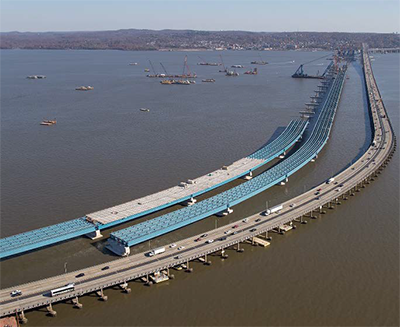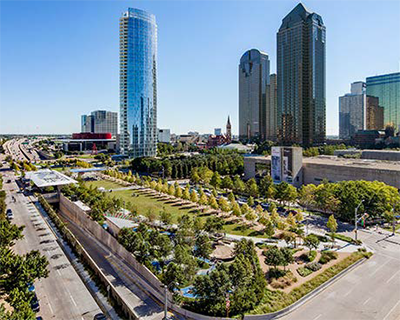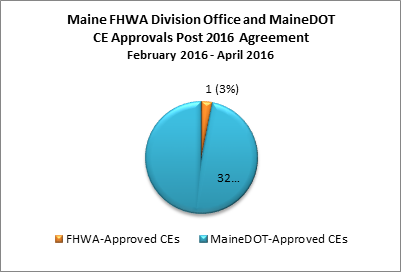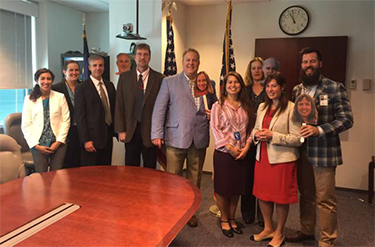
A Year in Review: Practical Ways to Implement Takeaways
from the 2016 Newsletters
From best practices in conducting climate change resiliency assessments to methods for accelerating environmental review processes, 2016 was a year of exemplary steps towards the advancement and accelerating sustainable transportation practices. Whether they identified alternative funding sources to complete projects or developed programmatic agreements to improve entire programs, transportation agencies nationwide shortened project delivery timelines and saved resources. Highlighting such successes in accelerating environmental reviews allows transportation agencies to not only review and improve their own processes, but it also builds greater awareness
In honor of the 15th year of this newsletter, this issue distills the most important takeaways from each issue in 2016. These takeaways are divided into projects and processes. Project takeaways include best practices to apply at the project level, and process takeaways can be applied at the agency level. Each takeaway includes specific information on how to apply these best practices and describes the top benefits of doing so.
Project Takeaways: How to Focus the Scope, Speed Up Reviews, and Creatively Fund Projects
Focusing the Scope and Objectives
Transportation agencies can tailor projects to the scale and priorities most relevant and pertinent to an area or community.
Here’s How: Using a framework can help agencies focus the scope and objectives of their projects by identifying key considerations, questions, and resources. As demonstrated in the January 2016 issue, the Metropolitan Transportation Commission (MTC) in San Francisco and the New York State Department of Transportation (NYSDOT) used such a framework to refine adaptation options for important transportation assets vulnerable to the impacts of climate change. NYSDOT focused on flooding within the State and its impact on culverts, and MTC focused on climate threats to roads, rail, and transit infrastructure in Alameda County. Rather than trying to tackle all of the potential impacts of climate change across the State or region—a monumental task—each agency focused its resources and expertise on specific areas, assets, and climate impacts.

Tappan Zee Bridge under construction (courtesy of New York State Thruway)
Top Benefit: By tailoring assessments to the scale and priorities of the State or region, agencies can focus funding on the projects that matter and get to the root of the issue more quickly than a more expansive assessment. Assessment results can be more easily used to inform the development of specific adaptation strategies for assets identified as highly vulnerable to climate change. In other situations, unrelated to climate change, agencies can use assessments or pilot projects to evaluate alternatives and make better investment decisions.
Conducting Concurrent Reviews
For large projects, transportation agencies and their partners can enable concurrent reviews across agencies and with the public by frequently convening meetings that focus participants on the materials at hand.
Here’s How: There are several best practices for enabling concurrent environmental reviews between partner agencies. The State may submit a draft Environmental Impact Statement and associated documents to the Federal Highway Administration (FHWA), and they then coordinate reviews and comments with the State. State and Federal agencies may alternatively engage in a concurrent review process by drafting and editing environmental review documents together. To further expedite the process, partner agencies might also consider holding monthly calls or meetings where one or more individuals from each agency represents their agency’s interests and goals. Inter-agency meetings or calls like this encourage trust and transparency between the involved parties. In the case of the Tappan Zee Bridge Replacement project included in the February 2016 issue, this process allowed parties to produce a final EIS and complete the NEPA process in just 12 months.
Top Benefit: Concurrent reviews allow partner agencies to drastically shorten the usual timeframe for conducting environmental reviews. By expediting the review process, critical transportation projects can begin and end in a shorter time span; ensuring that goods, people, information, and energy can move efficiently throughout the country.

Klyde Warren Park is a green oasis in the midst of Dallas’ many roadways (courtesy of Klyde Warren Park)
Finding Alternative Funding Sources
Budgets are tightening or being stretched to cover more tasks, so it is important to look beyond traditional funding to complete necessary work.
Here’s How: One way to ensure sufficient funding is available for a project is to identify multiple and varied funding sources. Potential funding sources include Federal, State, and local grants, private partnerships, and other financial incentive programs that accept government applicants. For example, in the March 2016 issue, the Missouri Department of Transportation’s Park Over the Highway project and the Texas Department of Transportation’s Klyde Warren Park project showcased the ways in which agencies can work with public and private partners across all levels of government to fund projects.
Top Benefit: Using multiple funding sources on a project ensures sufficient funding is available in case the scope or schedule changes or a planned funding source is no longer available. Additionally, multiple funding sources often allow agencies to complete projects more quickly, engage local stakeholders, and even allow parties to donate in-kind services.
Process Takeaways: How to Use Experts, Data, and Agreements to Improve Processes
Building and Using Expert Networks
Establish and maintain a network of existing subject matter experts (SMEs) either within a State or nationally. Such networks can be useful for finding information on emerging or complex topics, and for filling in staffing or funding gaps.
Here’s How: To build and employ a SME network, agencies can promote informal idea- and information-sharing internally and externally. This way, when an issue is identified that cannot be handled internally or would benefit from additional expert input; there is already a network in place. As highlighted in the April 2016 issue, Animal Road Crossing (ARC) Solutions―a coalition of partners across the public, private, non-profit, and higher education sectors in the United States and Canada―established a network of SMEs to call on for input on pressing wildlife-vehicle interaction issues in North America. This network has proven so successful in developing innovative ways to reduce conflicts between animals and motorists that ARC Solutions earned an Environmental Excellence Award from FHWA in 2015.
Top Benefit: By identifying SMEs within the field that are willing and able to provide ad hoc information and guidance, agencies can apply innovative and cost-sharing solutions to budget constraints and staffing uncertainties. Additionally, SME networks help maintain a diverse range of knowledge bases and opinions, leading to more well-rounded decisions from the agency.
Using Historical Data to Make Improvements
Identifying bottlenecks and related trends using existing or new data sources can inform process improvements.

Thanks to the new Maine CE agreement, FHWA will review less than 5 percent of MaineDOT CEs. (courtesy of MaineDOT)
Here’s How: To accelerate environmental review procedures, agencies can review their existing processes to determine where steps can be shortened or eliminated, as well as where they could be made more effective and efficient. To assist in accelerating environmental reviews, agencies should review historical data to identify key themes in actions and their related impacts. Often, agency processes can be consolidated into a shorter timeline while still achieving the same results and meeting the necessary requirements. The June 2016 issue demonstrated how the Maine Department of Transportation successfully updated its Programmatic Categorical Exclusion agreement by reviewing its past decisions and identifying trends. This allowed the agency to reduce the number of threshold questions in its agreement, make remaining questions more indicative of potential environmental impacts, and shorten the time spent processing Categorical Exclusions.
Top Benefit: By accelerating environmental review processes, agencies can save time and money, and potentially expedite the timeframe of their projects. Programmatic processes can also highlight additional opportunities to expedite environmental reviews for a project or program.
Developing Programmatic Documents
Whether protecting bats or preserving bridges, establishing a programmatic consultation or agreement can focus priorities, generate consensus, define roles, and establish and simplify processes.

The Indiana Bat and
NLEB
Working Group signed the Programmatic Biological Opinion in June 2016 (courtesy of Sharyn LaCombe, FTA)
Here’s How: To develop programmatic documents for an environmental review process, transportation agencies can partner with stakeholder agencies to discuss and document ideal processes, priorities, and frameworks. By developing programmatic documents for specific actions, agencies can expedite actions and begin moving through a well-established process. This method can be effective when bringing together stakeholders to solve multi-state challenges. In the case of the endangered Indiana bat and threatened Northern long-eared bat, highlighted in the September 2016 issue, FHWA, the Federal Railroad Administration, and the Federal Transit Administration partnered with the U.S. Fish and Wildlife Service to develop a programmatic consultation that implements a conservation strategy for bats and accelerates environmental reviews. The programmatic consultation for the Northern long-eared bat covers 37 States and the District of Columbia and it covers 22 States for the Indiana bat. It reduces timeframes for formal consultation from 135 days to 30 days, and for informal consultation from 30 days to 15 days. In the November 2016 issue, the Louisiana Department of Transportation and Development (LADOTD) worked with the Louisiana State Historic Preservation Office and the FHWA Louisiana Division Office to establish a methodology for identifying historic “Preservation Priority” bridges. The methodology and corresponding Programmatic Agreement (PA) helped the LADOTD inventory all pre-1971 bridges in Louisiana, and LADOTD uses the PA for Section 106 review of projects with the potential to affect bridges.
Top Benefit: Developing programmatic documents increases the consistency of design and review processes in State or regional contexts, expedites project timeframes, and reduces environmental review delays. Programmatic approaches also improve environmental outcomes such as species protection or historic preservation by using established procedures to identify impacts and guide consultation and decision making.
Expediting Environmental Reviews Takes Many Forms but Produces Similar Successes in Stewardship
Every takeaway will not be applicable to every agency, but there is certainly a lot that can be learned from understanding how other agencies are tackling common problems and improving their processes. In 2016, agencies shared that projects are often best served through developing strong relationships with partners and SMEs; by being flexible on funding sources; and through understanding and defining project scope before implementation. Additionally, using data from past projects to improve the direction and success of future projects, and establishing programmatic approaches for consistency in decision making on similar projects, both demonstrate successes in stewardship.
Contact Information
Felicia Alexander
Program/Policy Development Team Leader
Office of Planning, Project Development & Environmental Review
Federal Highway Administration
Felicia.Alexander@dot.gov
202-366-2851
Look What’s New!
- Stay tuned for the new and upcoming, FHWA “Back to Basics” newsletter series debuting in January and scheduled once per quarter (April, July, and October) in 2017. These issues will provide a more detailed look at some of the topics most relevant to field practitioners.
- FHWA announced an applied research funding opportunity for transportation agencies to use its Infrastructure Voluntary Evaluation Sustainability Tool (INVEST) to assess and enhance the sustainability of their projects and programs. The deadline for submitting letters of interest is January 5, 2017.
Successes in Stewardship is a Federal Highway Administration newsletter highlighting current environmental streamlining and stewardship practices from around the country. Click here to subscribe, or call (617) 494-3719 for more information.

